A couch is more than just a piece of furniture. It’s where we relax after a long day, binge-watch our favorite shows, or chat with friends. But for many couples or first-time homeowners, buying a new couch can be a serious hit to the wallet. Prices for quality sectionals and upholstered sofas are steep, and not everyone has thousands to spare.
That’s why building your own DIY storage couch out of plywood is a game-changer.
This guide will walk you through everything—from design basics to customizations like arms, legs, and upholstery. Whether you’re a beginner woodworker or just love the idea of custom furniture, this tutorial offers a practical solution that looks great and functions even better.
🪑 Why Build Your Own Couch?
Let’s be real—modern sofas are expensive, often poorly made, and rarely fit unique room dimensions. By building your own couch, you can:
- Customize the size to fit your space
- Add built-in storage underneath
- Save hundreds (if not thousands) of dollars
- Use higher-quality materials
- Add personal flair with fabric, cushions, and legs
You don’t need pro-level skills either. If you can measure, cut, and screw plywood together, you can make a couch.
🧰 Materials and Tools
Here’s what you’ll need for your DIY couch project:
🪵 Materials:
- 3/4-inch cabinet-grade or marine-grade plywood (Buy on Amazon)
- 2″ wood screws
- Wood glue
- Sandpaper (120–220 grit)
- Foam rubber (for cushions) (FoamTouch High Density Foam)
- Upholstery fabric (Heavy Duty Canvas or Velvet)
- Piping cord for cushions (Get Upholstery Piping Here)
- Optional: Pre-made sofa legs (Mid-Century Legs)
🔨 Tools:
- Circular saw or table saw
- Power drill with screwdriver bits
- Orbital sander
- Jigsaw (for cutting curves)
- Clamps
- Sewing machine (optional, for cushions)
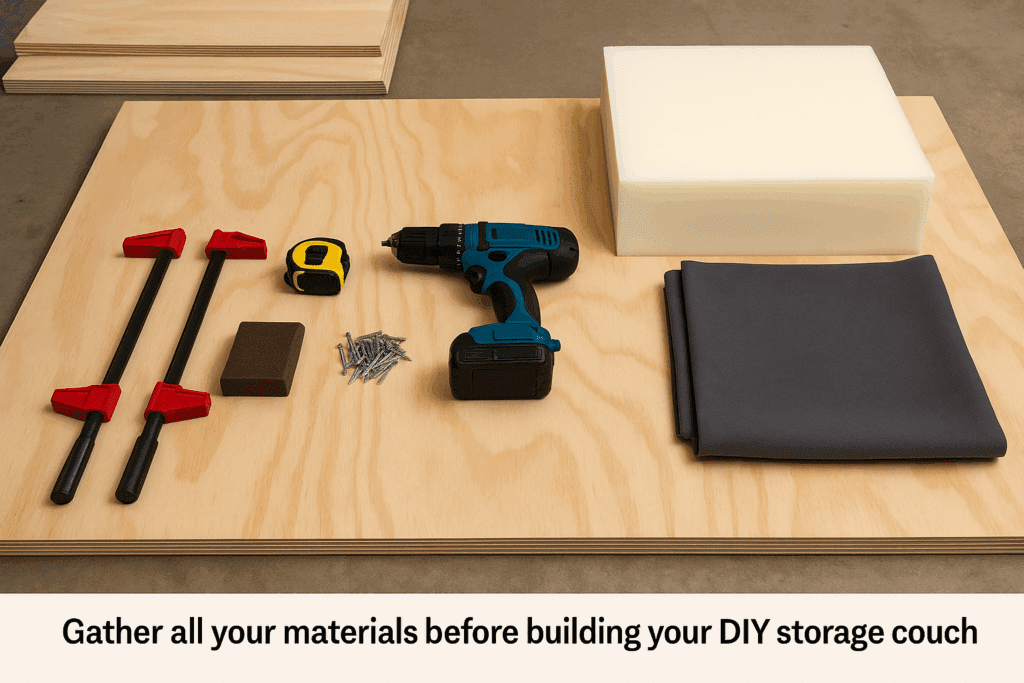
🪑 Basic Couch Dimensions
Before you cut any wood, let’s talk dimensions. A standard sofa’s ergonomics are:
- Seat height: 18” from the ground
- Seat depth: 24” from front to back
- Backrest angle: 15° for a comfortable recline
- Backrest height: Usually 26”–32”
- Overall length: 72” for a 3-seater; 48” for a loveseat
Adjust dimensions to fit your space. Be sure to factor in cushion thickness—if you’re adding 4” foam, reduce the wood seat height accordingly.
🧱 Building the Couch Frame
Step 1: Cut the Side Panels
Cut two identical end pieces from plywood—these form the couch’s arms and side supports. Include curves or angled backs for extra style.
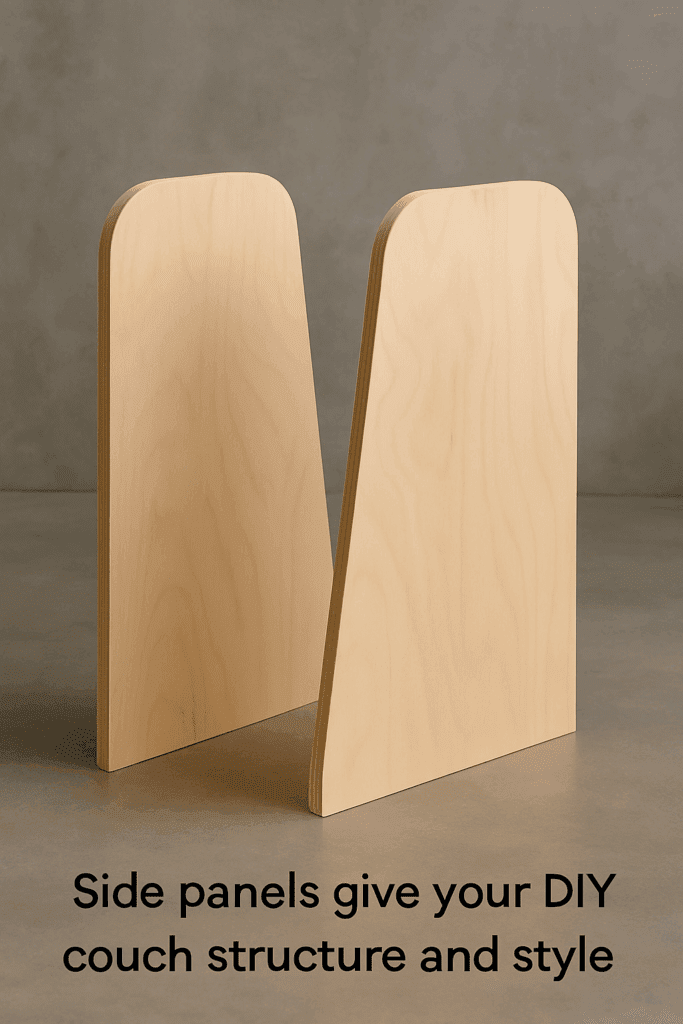
Step 2: Attach Seat and Backrest
Cut two long plywood panels:
- Seat base: 24” wide by your desired length
- Backrest: Match seat length, angled back 15°
Attach the seat and back between the two end pieces using wood screws and glue. Reinforce with 2″ support strips beneath the seat panel.
📦 Add Built-In Storage
Why stop at seating when you can have hidden storage too?
- Cut a rectangle out of the seat panel’s top
- Use hinges to attach the cutout as a lid
- Add a divider underneath for a cubby-style storage bin
Use this space for storing blankets, games, or kids’ toys.
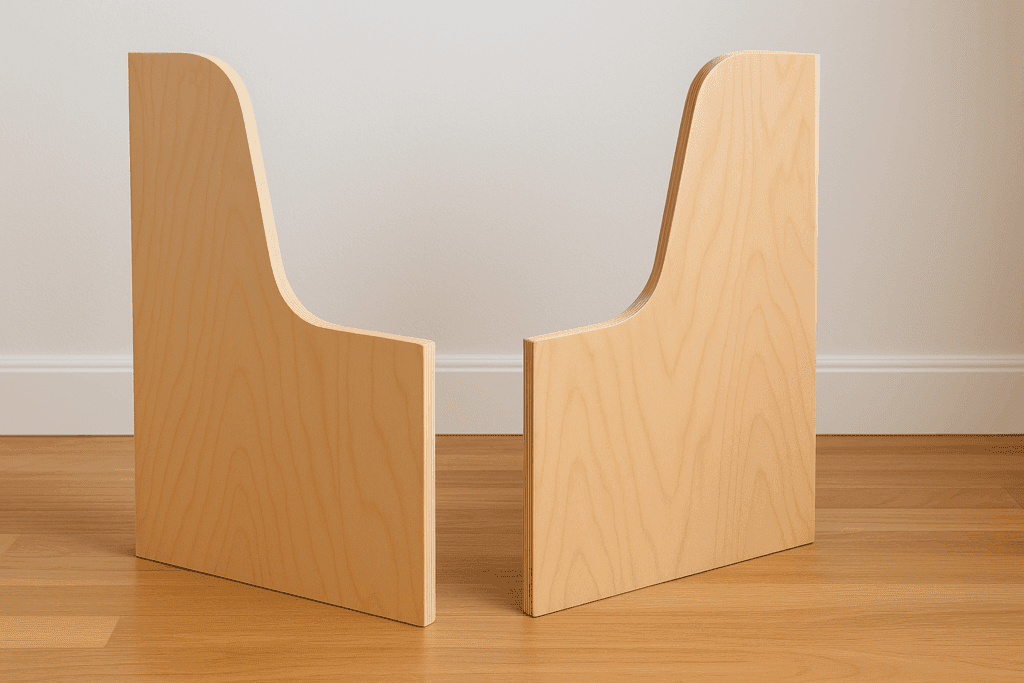
💡 Optional Modifications
Let’s explore some creative add-ons that elevate your homemade couch from basic to beautiful.
1. Add Arms
To make box-style arms, extend the side panels upward by 9–12 inches. For extra comfort, top each arm with a 3” strip of plywood, slightly overhanging the frame.
You can even upholster the arms or add cup holders for a media room vibe.
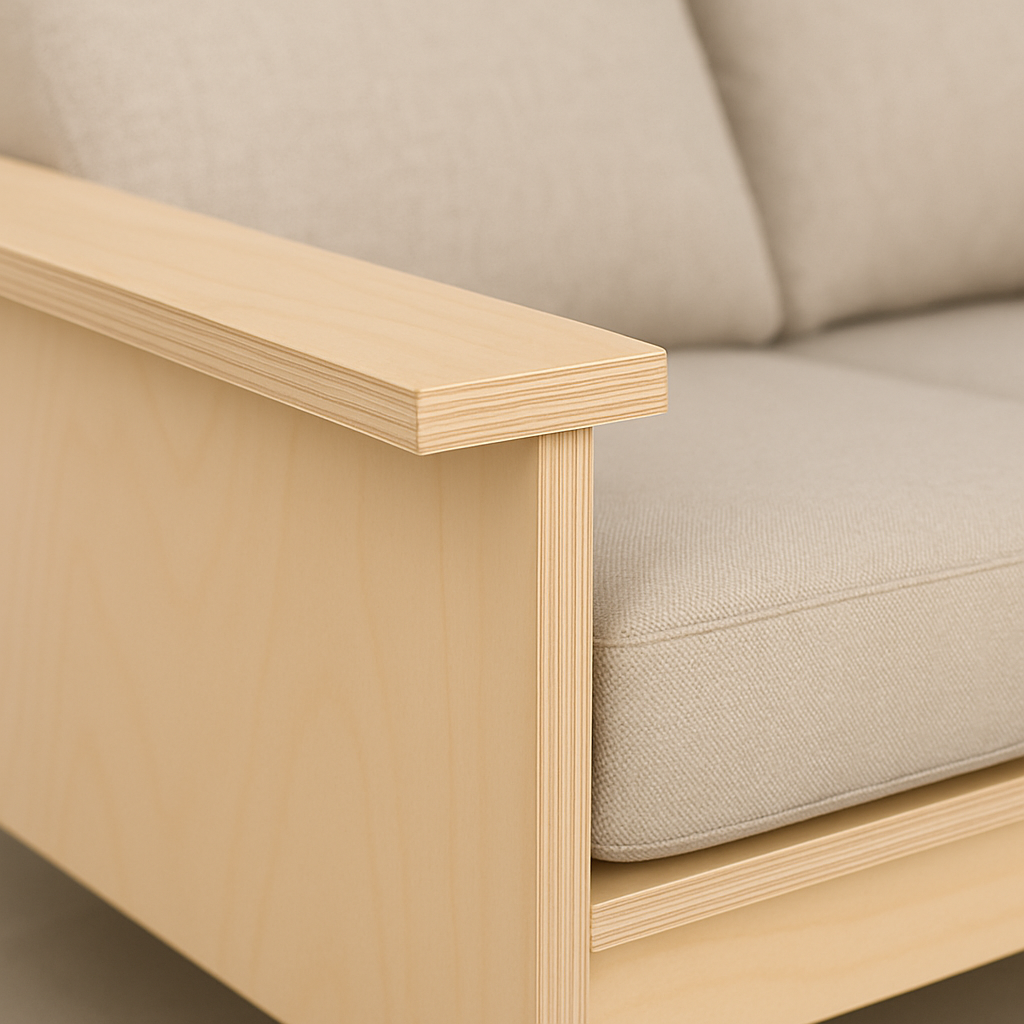
2. Add Legs
If you want a lifted look, trim 4–6 inches off the bottom of the side panels and attach pre-made legs. This makes the couch easier to clean underneath and adds an airy feel.
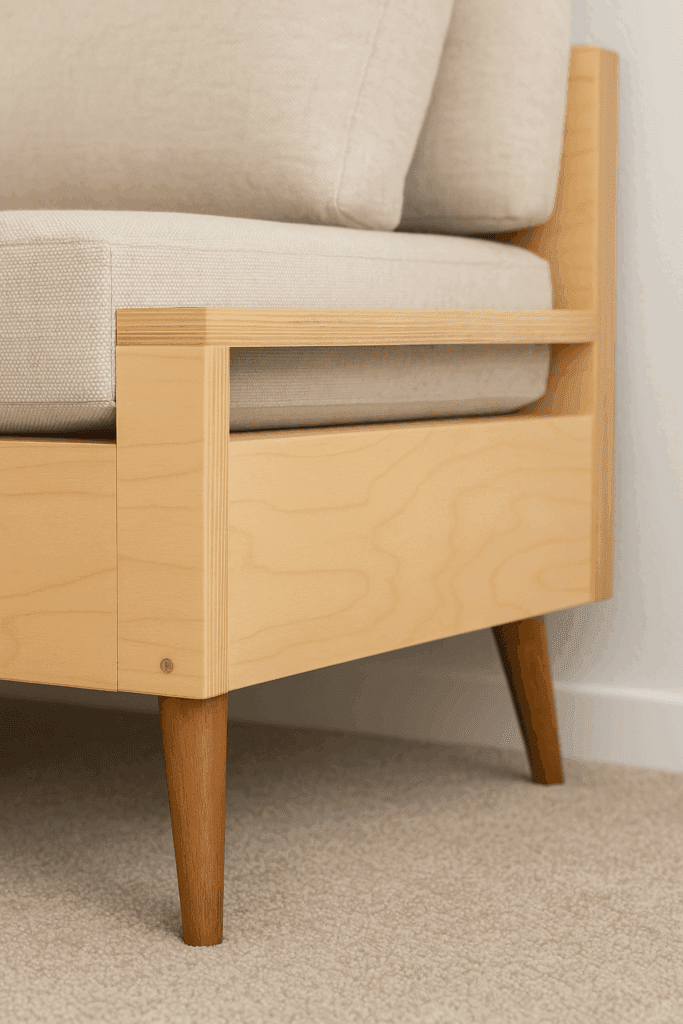
3. Upholster With Foam Cushions
Cushions make or break the comfort level of your couch. Don’t skip this step.
How to make your own cushions:
- Cut foam rubber blocks to fit your seat and backrest
- Sew fabric covers with zippers (machine-washable!)
- Add piping around the seams for a polished look
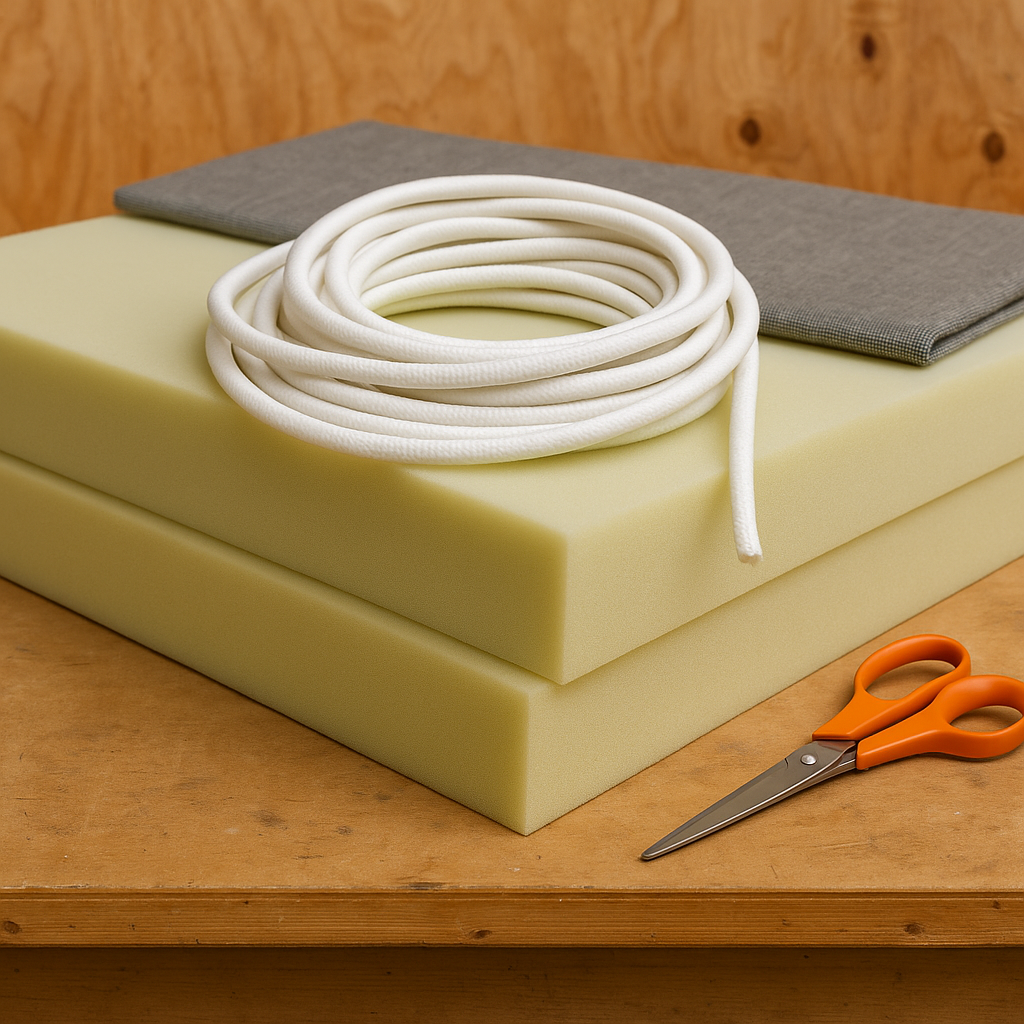
If sewing isn’t your strength, try these pre-made cushion options:
🧵 Making Couch Cushions That Feel Good
If you’re putting in the effort to build your couch, don’t cut corners when it comes to the cushions. The frame might be the bones, but the cushions are the soul. They’re what turn your build from “nice idea” to “wow, this is comfortable.”
You don’t need to be a designer to get it right—just think about how you want the couch to feel when you sit down. Some people prefer a firmer seat that supports them without sinking in too much. Others want a soft, cozy couch that almost hugs you. There’s no single right answer, which is the beauty of doing this yourself.
Most big-box couches use medium-density foam, but you can do better. High-density foam works great for seats—it holds up longer and doesn’t flatten after a few months. If you want something softer, just add a thin layer of memory foam on top. I’ve seen people even mix two types of foam for the best of both worlds: support underneath and softness on top.
Now, onto fabric. This is where you get to show some personality. Want a clean, modern look? Go with tightly-woven microfiber. Going for farmhouse or cottage vibes? Canvas or linen blends can work beautifully. Have a dog that sheds like crazy? Try something dark and easy to vacuum. Honestly, this part is less about rules and more about what makes you smile every time you walk into the room.
And don’t forget the function. Adding zippers to your cushion covers might take a little more effort upfront, but it’s 100% worth it. Life happens—spills, dirt, pizza nights—and being able to unzip and toss the cover in the wash will save your couch again and again.
One tip I wish I had learned earlier: test it. Before you staple or sew anything permanent, throw your foam and fabric on the frame and sit. Lie back. Take a moment. You’ll know if it needs tweaking.
This is the moment where your couch becomes something you look forward to coming home to. It’s not just a seat—it’s the best spot in the house, built with your own two hands and designed exactly the way you like it.
🧽 Finishing Touches
Sanding
Sand all plywood edges to eliminate sharp corners and splinters. Round off the corners for a safer, smoother look.
Staining or Painting
Use wood stain for a warm, rustic look or matte paint for a modern finish. Consider sealing it with polyurethane for durability, especially if kids or pets are involved.
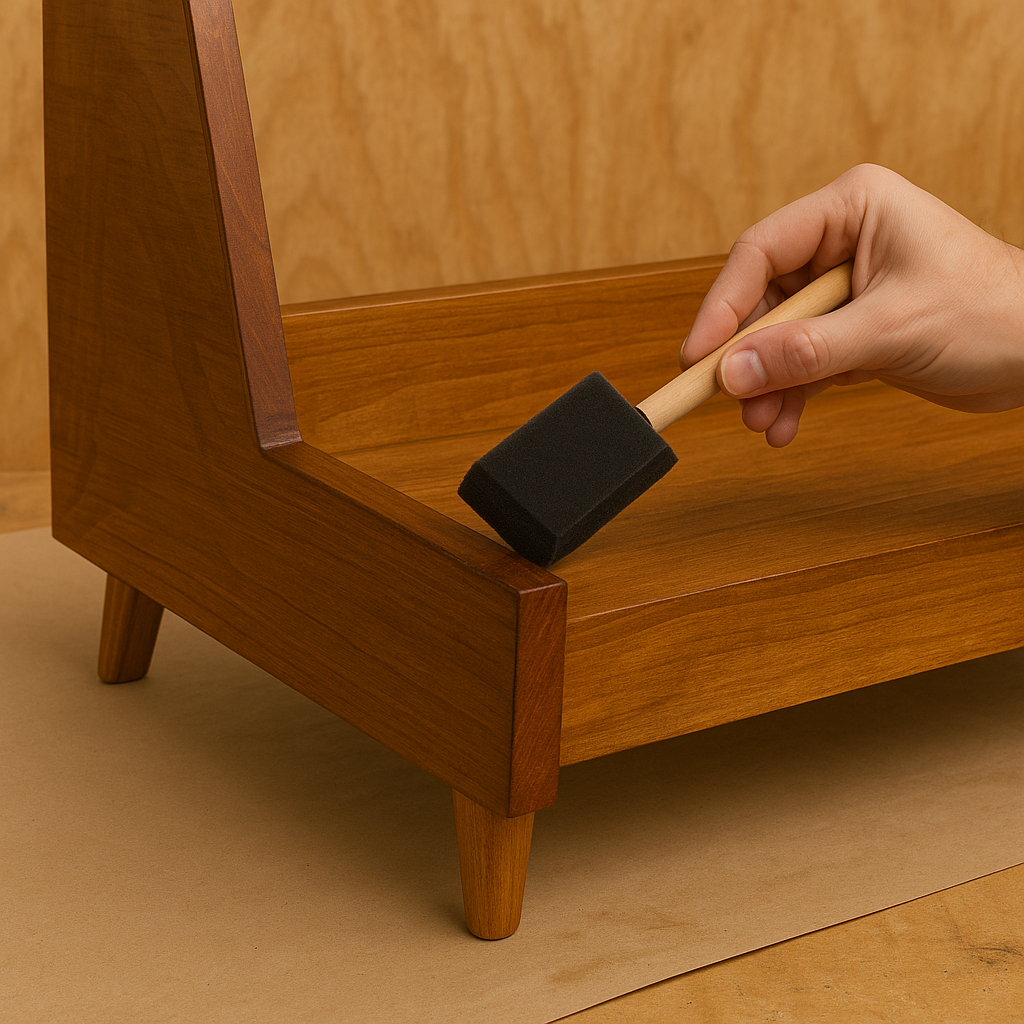
🛋️ Benefits of a DIY Couch
Making your own couch isn’t just about saving money—it’s about crafting something meaningful. Here are the top reasons people love their homemade sofas:
- Custom size: Fits any corner, wall, or nook
- Extra storage: Save space in small apartments
- Creative freedom: Choose your colors, shape, and materials
- Pride of build: Every couch has a story, and this one starts with you
🛒 Amazon Product Picks for Your DIY Couch
| Product | Use | Link |
|---|---|---|
| Cabinet-Grade Plywood | Frame construction | ✅ |
| FoamTouch 4” High-Density Foam | Cushions | ✅ |
| Upholstery Piping Cord | Cushion detailing | ✅ |
| Mid-Century Sofa Legs | Stylish legs | ✅ |
| Heavy Duty Upholstery Fabric | Covers | ✅ |
| Zipper Sewing Kit | Cushion covers | ✅ |
🧵 Final Thoughts: Build It Your Way
The best part about building your own couch is the creative control it gives you. You’re not stuck with showroom colors, overpriced cushions, or too-big sectionals. You’re building a piece that fits your lifestyle and space, down to the inch.
Start with a simple boxy build, then add features as you go. Upholster it to match your room, elevate it with legs, and finish it with pillows and throws. The result? A beautiful, functional couch made by hand—and built to last.



